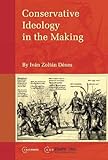Conservative Ideology in the Making / Ivan Zoltan Denes.
Material type: TextSeries: Pasts Incorporated: CEU Studies in the HumanitiesPublisher: Budapest ; New York : Central European University Press, [2009]Copyright date: 2009Description: 1 online resource (292 p.)Content type:
TextSeries: Pasts Incorporated: CEU Studies in the HumanitiesPublisher: Budapest ; New York : Central European University Press, [2009]Copyright date: 2009Description: 1 online resource (292 p.)Content type: - 9786155211782
- Conservatism -- History -- 19th century -- Hungary
- Conservatism -- Hungary -- History -- 19th century
- Liberalism -- History -- 19th century -- Hungary
- Liberalism -- Hungary -- History -- 19th century
- Minorities -- History -- 19th century -- Hungary
- Minorities -- Hungary -- History -- 19th century
- Nationalism -- History -- 19th century -- Hungary
- Nationalism -- Hungary -- History -- 19th century
- Political culture -- History -- 19th century -- Hungary
- Political culture -- Hungary -- History -- 19th century
- Social classes -- History -- 19th century -- Hungary
- Social classes -- Hungary -- History -- 19th century
- POLITICAL SCIENCE / Political Ideologies / Conservatism & Liberalism
- Conservatism, Hungary, Ideology, Political parties, Political philosophy, Political studies
- 320.5209439/09034 22/eng/20231120
- online - DeGruyter
| Item type | Current library | Call number | URL | Status | Notes | Barcode | |
|---|---|---|---|---|---|---|---|
 eBook
eBook
|
Biblioteca "Angelicum" Pont. Univ. S.Tommaso d'Aquino Nuvola online | online - DeGruyter (Browse shelf(Opens below)) | Online access | Not for loan (Accesso limitato) | Accesso per gli utenti autorizzati / Access for authorized users | (dgr)9786155211782 |
Frontmatter -- Table of Contents -- Foreword -- Iván Zoltán Dénes -- Conservatism -- The Liberal Challenge: Nation-Building through Reforms -- The Conservative Answer: Law, Order, and Stability -- The Conservative Answer: Law, Order, and Stability -- Epilogue -- Primary Sources and Literature -- Index -- Illustrations
restricted access online access with authorization star
http://purl.org/coar/access_right/c_16ec
The fifty years or so preceding the watershed of 1848–49 witnessed the emergence of liberal nationalism in Hungary, along with a transmutation of conservatism which appeared then as a party and an ideological system in the political arena. The specific features of the conservatism, combining the protection of the status quo with some reform measures, its strategic vision, conceptual system, argumentation, assessment criteria and values require an in depth exploration and analysis. Different conservative groups were in the background or in opposition from 1848 to 1918, while in the period between the two World Wars, they constituted the overwhelming majority of ruling parties. During the one-party system, from 1949 to 1989, the liberals and conservatives—like all other political groups—were illegal, a status from which they could later emerge upon the change of the political system. The inheritance of the autocratic system frozen up and undigested by the one-party state was thawed after the peaceful regime change, the constitutional revolution and its discrete components began to be reactivated, including the enemy images of earlier discourses. "Liberal" and "conservative" had become state-party stigmas in line with fascist, reactionary, rightist, and bourgeois. In reaction to that, at first conservative then liberal, intellectual fashions and renascences unfolded in the 1980s. The attempts by liberal and conservative advocates to find predecessors did not favor an objective approach.The first step toward objectivity is establishing distance from the different kinds of enemy images and their political idioms. This is a pressing need because, although several pioneering works have appeared on different variants of the Hungarian liberalisms and conservatisms, there are no serious unbiased syntheses. This work is urgent because the political poles of the constitutional revolution and the ensuing period have up till now been described in terms of different conspiracy theories.
Mode of access: Internet via World Wide Web.
In English.
Description based on online resource; title from PDF title page (publisher's Web site, viewed 20. Nov 2024)


